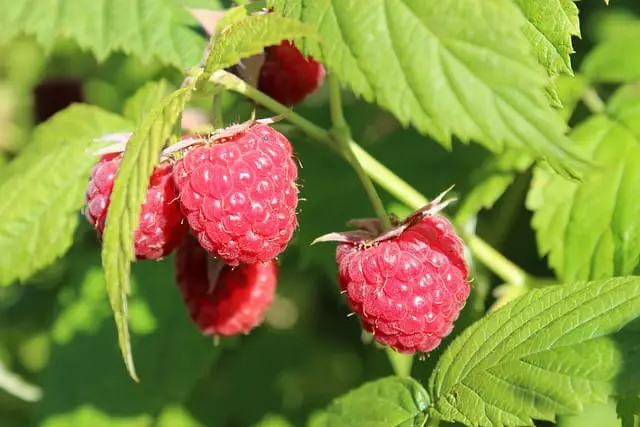With their inviting rich color, unique taste, and nutritional values, raspberries are desirable fruits every time. But do you know that there are plants that look like raspberries?
Not only do some of these plants share similar features with raspberries, but they also have the same taste. Knowing the differences between raspberries and their look-alikes will help you make appropriate choices. So in a situation where you’re craving any of these fruits, there won’t be any confusion.
In this article, we will list and discuss 10 plants that look like raspberries. Get comfortable and keep on reading!
10 Plants That Look Like Raspberries
Below are some of the plants that share some physical features with raspberries.
- Salmonberry (Rubus Spectabilis)
- Thimble Berry (Rubus Parviflorus)
- Red Mulberry (Morus Rubra)
- Cloudberries (Rubus chamaemorus)
- Autumn Olive(Elaeagnus umbellata)
- Japanese Wineberry (Rubus phoenicolasius)
- Tayberries (Rubus Fruticosus x R. Idaeus)
- Boysenberries (Rubus Ursinus x R. Idaeus)
- Cranberry (Vaccinium subgenus)
- Redcurrant (Ribes rubrum)
Let’s discuss these plants one after the other.
Also read:
1. Salmonberry (Rubus Spectabilis)
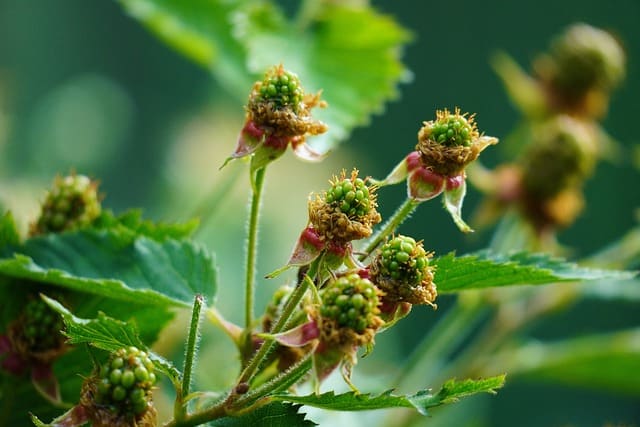
Not only do salmonberries have a similar shape to raspberries, but they also have the same size. In some cases, salmonberries also have the same red color as raspberries. Other times, they come in yellow and orange.
Salmonberries are native to North America’s west coast. They can be found mostly in stream banks, shorelines, bogs, and moist coastal forests. Leaves are usually ovate, consisting of three leaflets that can be between 7 and 22 cm long.
Salmonberries produce flowers from early spring to early summer. Under normal conditions, the fruits become ripe from early May to late July. When ripe, the fruit can be eaten raw or used in the production of wine, jelly, candy, or jam.
2. Thimble Berry (Rubus Parviflorus)
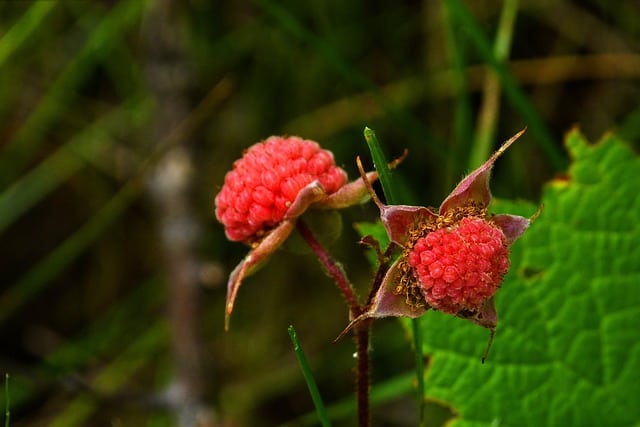
Native to the northern regions of North America, thimbleberries also look similar to raspberries. However, thimbleberry is an aggregate fruit and not a true berry. And like the other plants in the Rubus genus, thimbleberry has no prickles.
Generally, this plant grows in clumps that spread through its underground rhizome. Its leaves have a soft and fuzzy texture and can grow up to about 20 cm. In addition, thimbleberries produce flowers between 2 and 6 cm in diameter, making them one of the Rubus species with the largest flowers.
As a result of their soft texture, thimbleberries are not commonly used for commercial purposes. Nevertheless, the fruits can be eaten raw or processed into jams. In some parts of the world, parts of the plant are used as a cure for acne, digestive problems, and wounds.
3. Red Mulberry (Morus rubra)
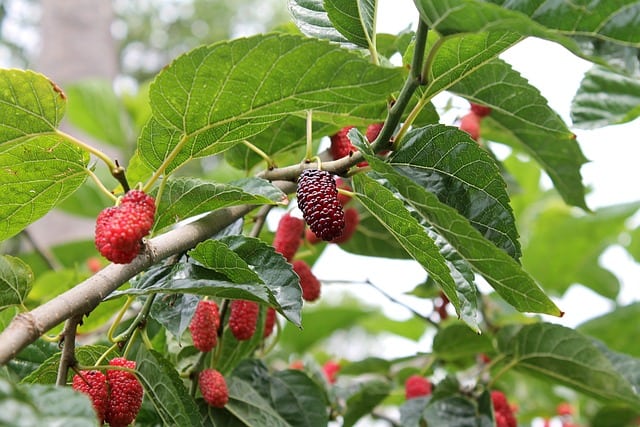
While red mulberry is not as common as white mulberry, it offers nutritional and ornamental benefits. The red mulberry is native to eastern and central America and belongs to the mulberry species. Its trees can grow up to 35–50 feet with rough leaves of about 7–18 cm long and 8–12 cm wide.
As the leaves emerge, small flowers of reddish-green or yellowish-green begin to open. Red mulberries can tolerate pollution, poor soil, and drought. And they’re highly attractive to birds, especially during the spring and early summer.
Like most berries, mulberry fruits are edible and have a juicy taste. While it can be eaten in its raw form, mulberries can also be used for the production of wine and pastry fillings. Certain tribes use the bark and sap of the plant for medicinal purposes.
4. Cloudberries (Rubus chamaemorus)
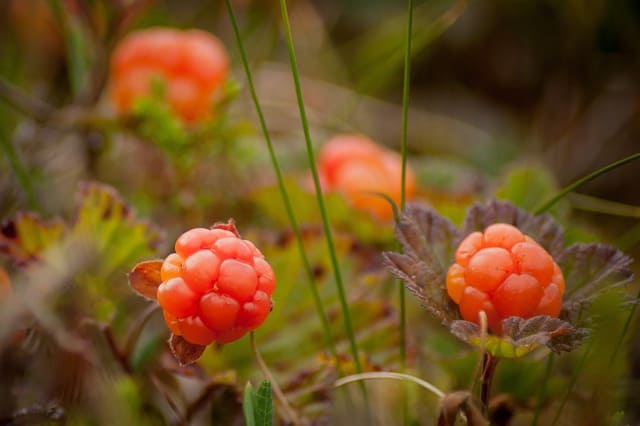
Also known as Nordic berry, and knotberry, cloudberry is a perennial plant that produces fruits that share a resemblance with raspberries.
Mature cloudberries grow to about 4–10 inches in length and produce many white flowers, especially when surrounded by trees and bushes. When ripe in early autumn, the cloudberry fruits gradually change color to amber.
When still fresh, cloudberries have a tart taste but have a sweet taste and a creamy texture when overripe. They can also be processed into jams, liqueurs, and juices. In addition to their delightful taste, cloudberries are a rich source of vitamin C. Some cosmetic products, such as body lotions and shower gels, contain cloudberry extract.
5. Autumn Olive (Elaeagnus umbellata)

Native to Eastern Asia, autumn olive is a hardy and invasive species that can take over an area quickly. Other names for this plant are spreading oleaster, Japanese silverberry, and autumn elaeagnus.
Autumn olive grows up to about 11 feet tall and produces sweet-smelling flowers of white or yellow. Its leaves are typically about 4–10 cm long and 2–4 cm wide, with silvery scales on their surface. But as summer approaches, the leaves change to green and the silvery scales fade away.
As the autumn olives’ fruits begin to ripen, their color changes from yellow to red with silver or brown dots. These red berries look similar to raspberries and also have a sweet flavor. While they can be eaten raw, autumn olive fruits can be processed into jam or used in place of tomatoes.
6. Japanese Wineberry (Rubus phoenicolasius)
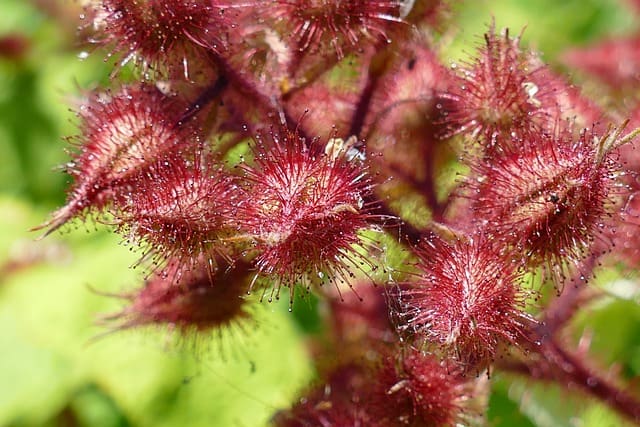
Among the plants that look like raspberries are the Japanese wineberry. They are an Asian species of raspberry and are native to Japan, Korea, and China. Nevertheless, the plants can be found in other places, including New England, Canada, Georgia, Michigan, and Illinois.
Japanese wineberries grow to about 2.7m in height and produce flowers of about 6–10 mm in diameter in late spring.
Its fruits are usually produced in summer or early autumn. They can have an orange or red color, and have the same taste as raspberries. As with raspberries, Japanese wineberries are used for the production of pastries and other treats.
Interestingly enough, these sweet berries are considered invasive species in some places, including Colorado, Washington DC, and Tennessee.
7. Tayberries (Rubus fruticosus x idaeus)
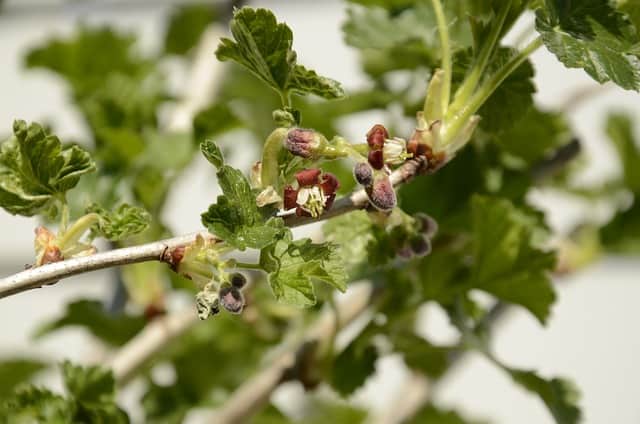
Like Loganberry, Tayberry is a hybrid of blackberry and raspberry. It was named after the River Tay in Scotland.
While these berries look like raspberries, they are bigger, sweeter, and more delicate. Due to their soft nature, tayberries are not commonly used for commercial purposes. However, they can be cooked or eaten in their raw form. They can also be used for the production of wine, beer, and jams.
Mature tayberry fruits usually have a cone shape, and a reddish-purple color, and can grow up to 4 cm long. Tayberries are easy to grow and are resistant to diseases.
8. Boysenberries (Rubus ursinus x R. idaeus)
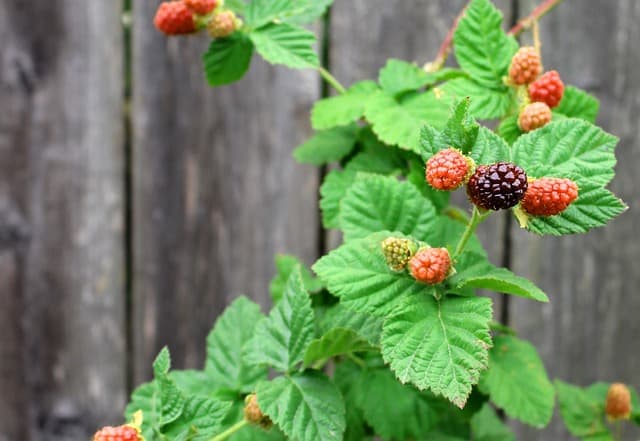
Boysenberry is a hybrid of loganberry, European blackberry, European raspberry, and American Dewberry. One of the similarities this berry shares with raspberries is its cone shape and clusters of fruits. However, it has a thinner and softer skin texture.
Ripe boysenberry fruits tend to create a mess as they leak juice quickly within a short time after harvest. While the fruits can also be eaten raw, they can also serve as an ingredient in making jam.
9. Cranberries (Vaccinium subg. Oxycoccos)
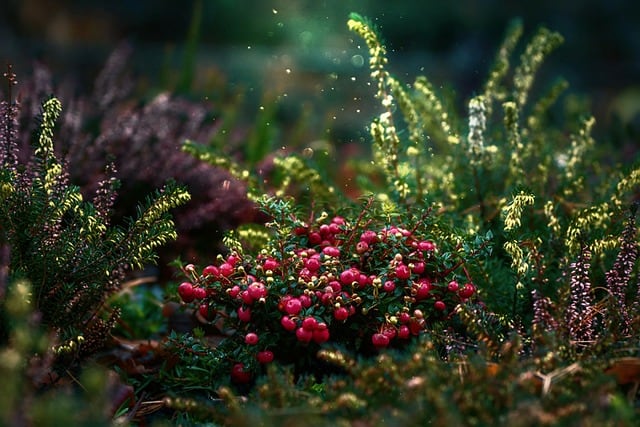
Cranberries are also one of the plants that look like raspberries. They produce dark pink flowers that are usually pollinated by bees and fruits that change to red from green when ripe.
Even though cranberry fruits have a sweet taste, they are slightly acidic. Most of the time, the fruits are used for the production of jam, juice, and sauce. They can also be used as an ingredient in bread, cakes, and muffins.
10. Redcurrant (Ribes rubrum)

Native to Western Europe, redcurrants produce red fruits that are good for nutritional and ornamental purposes. Typically, this plant grows up to 1.5 m tall and produces yellow-green flowers. The redcurrants produce red fruits from late June through mid-July.
Due to their high organic acid content with polyphenols, these fruits have a tart taste but they are rich in Vitamin C. Regardless, the fruits can be eaten raw or added to salads or drinks. Mature redcurrants are usually tough, requiring low maintenance.
Final thoughts
When eating any of these plants that look like raspberries, practice moderation. Due to these fruits’ sweet taste, you may be tempted to eat as many as possible.
But eating too many of these fruits at a time can cause diarrhea and other stomach issues. If you notice any allergic reactions while eating any of these berries, stop eating them.
Frequently Asked Questions
What Fruit Looks Like a Giant Raspberry?
Mulberries are fruits that look like giant raspberries. They come in red, purple, white, and black. While mulberries are sweet fruits, they have a slightly sharp taste.
How Do I Identify a Raspberry?
Raspberries are easy to identify by their alternate, compound leaves with about 3 or more leaflets and zigzag margins. They share a close resemblance with blackberries but can have a purple, red, black, or golden color. Compared to blackberries, the central core of a raspberry remains in the plant when you pick its fruit.
Can You Eat Wild Raspberries?
Yes, it is perfectly safe to eat wild raspberries. It is highly nutritious, and flavorful and can have a dark purple or red color. Wild raspberries can grow in forest edges, roadside ditches, open fields, and abandoned gravel pits.

Hey, I’m Lisa and I’ve been an avid gardener for over 30 years. I love writing, talking and living in the garden! Feel free to connect with me on my socials below

